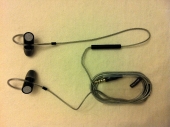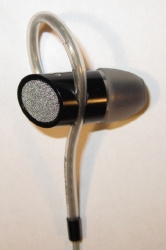Bowers and Wilkins was founded in 1965 as a boutique audio company. They spent the next 45 years building speakers, before stepping into the headphone with their P5 headphones, which were released to a fairly warm reception – they proved popular after the usual caution involved in a company introducing an entirely new product category, and likely created a whole new crop of audiophiles given their broad availability through featured placement at Apple stores. Since their introduction, B&W has not seen fit to update the P5, as they did it right the first time – this freed up their engineers to enter yet another potentially lucrative new market segment, in-ear monitors. The new C5 in-ear-monitors represent the fruits of this effort – and clearly, they don’t cut any corners. B&W has used expensive materials and manufacturing methods to create what seems to be a very durable product; even the cords appear sturdier than many competing IEMs, with better-than-average strain-relief in the plug. While on the topic of the cord, the C5 includes the Apple-designed inline mic and three button remote hanging below the left earbud. Also speaking of the cord, B&W has done something odd with it up near the earbuds, in order to supplement the normal retention methods which some find less than comfortable – they call it their “secure loop design” and it promises better retention with better comfort – we’ll have a look at that shortly.
 |
 |
 |
 |
The B&W C5 arrives packaged attractively, in a black box made of heavy cardstock which prominently features the earbuds themselves, first on the box art, which flaps open to expose the real deal through a window – which are pretty attractive in their own right. One gets access to the headphones through a panel in the bottom of the box, and a tray inside slides out containing the headphones on top, attached to a plastic insert. Underneath, one finds the included accessories, most importantly a small ziplock baggie full of silicone eartips, which are critical to to the sound of all IEMs, for their proper fit is necessary to produce anything resembling adequate sound. When one achieves this proper fit, they are generally rewarded with excellent sound, however. The C5’s selection runs toward the large end of the scale, but should fit a broad range of ears. Next to this, one finds a half-circle shaped headphone case with an internal cord-spindle, smelling strongly of real leather, though the lining appears to be a microfiber imitation suede, perhaps a concession to manufacturability as much as cost. Also packed in the space under the headphones themselves is a short but quite-adequate manual, and two adapters – one a right-angle plug for preventing cable strain or damage, the other an airline adapter. For the Macbook Air toting, jet-setting crowd, this will be a welcome addition… if people still watch in-flight movies instead of bringing their own content on their own devices. Still, batteries die and this should make a nice backup plan. Further, these adapters couldn’t have cost them much, but definitely contribute to the feeling that what you have in front of you is a high-end product.
I mentioned the multitude of silicone flange tips included in the box before, and let me return to this point – in any IEM, fit is critical to sound quality. All IEMs depend on achieving a good quality, airtight seal in the ear canal in order to produce sound. The B&W design is supplied exclusively with single-flange silicone tips; these are the easiest to insert and remove, but can be the most finicky compared to multi-flange designs (which can sit too deep for comfort, and are simply too long for some ear canals) or disposable “foamies” (which tend to get really nasty and require replacement every couple weeks to couple months). These supplied flange tips all run toward the larger end of the pack at the end the sound comes out of, and when I pulled off the attached bullet-shaped tips to try a smaller spherical tip, I discovered why – the sound tubes are, compared to many other IEMs, simply huge, with an outside diameter of four to five millimeters. In comparison, Future Sonic’s Atrio, as well as a few Shure models, are around 1.5 mm, and Apple’s dual-driver IEM clocks in at about 2.5mm. In spite of this, the smallest C5 eartip is slightly smaller than the smallest Apple eartip, and doesn’t have much room to spare for flex. On the other hand, if the small tips fit your ears well, you won’t need much flex. The monster tube also suggests they are capable of moving quite a lot of air, which makes me hopeful for their bass response. The unavoidable downside is that those users with smaller ear canals should consider looking elsewhere, or if particularly undaunted, consider custom-molded eartips. These can be expensive if made by an audiologist, but the daring could consider using a commercial earplug kit with directions found on the internet to roll a pair for under forty bucks. As always, the potential for an expensive mishap cannot be ruled out, so this is at your own risk. Though if any earbuds justify professionally-crafted custom tips, I must say that this is probably the pair!
Properly testing earbuds – and indeed any headphones is difficult, as some of the qualities being tested are subjective, and others depend on the structure of the user’s ear – especially with regards to IEM fitting, but also how a user perceives frequencies. For example, many people find they prefer bass-heavy earphones of some sort or another, though this is actually a bad thing – most music is mixed using very ‘flat’ speakers, which don’t emphasize any component of the music over the rest of it. This is what is referred to as a “natural” reproduction, and should be the goal of any self-respecting audio geek. (If it turns out you prefer more thump than you get with flat reproductions, there’s always the equalizer) Fortunately, good sound is no longer solely the purview of five-digit recording studios. As we examine the C5 to see if Bowers & Wilkins have managed to achieve good sound at bargain prices, there are a few things to keep in mind. First off is the phenomenon of burn-in – most expensive headphones are not shipped in an optimal configuration. Instead, they are shipped in a state that the first ten to fifty hours’ use will cause them to settle down into this optimal condition, where they will stay for the majority of their lifespan. Most cheap headphones, by contrast, are shipped in their optimal condition, and instead of burning in tend to shake themselves loose distressingly quickly. Most users choose one of two strategies related to burn-in – simply use the ‘phones out of the box and enjoy listening to the sound quality improving as they use them, or play a loop of pink noise overnight at slightly above normal listening volume. (but only slightly!) This usually produces a generally-adequate burn in without causing any undue stress, wear, or otherwise risking damage.
 |
 |
The C5 is built using fairly expensive methods and materials, from tungsten speaker components to give them a center of gravity inside your ear canal, to a fairly thick aluminum body for the sake of durability, to a unique, probably sintered, vent on the back of the earbuds made from tiny fused steel beads. This also implies that these IEMs are built using an open principle design, which for a given level of cost and energy use, will be both louder and higher-fidelity. This is a fairly rare design principle in IEMs, but hardly unheard of in high end headphones in general. The results of this design choice, in addition to the previously mentioned quality and power-efficiency advantages, are first off, decreased sound isolation, and second off, the unavoidable tendency of these headphones to share your music with everyone in the room, for instead of using air’s compressibility to allow them to move air into your ear canal, they rely on the entire atmosphere to dump excess pressure or vacuum into – thus sending an out-of-phase representation of the same sounds you are listening to into the local environment. This waste sound can be attenuated somewhat, but never eliminated entirely. As expected, the C5 was indeed louder at similar drive levels than comparable ‘buds. In a surprising reversal however, the C5 effectively dampened much more waste sound than expected – whether a feature provided by the “micro porous filter” or simply the necessity of moving a lot less air than full-size open principle headphones, the C5 are not likely to annoy those around you who may not appreciate the sort of music sharing open-principle often provides. Their mechanical noise isolation is also much better than expected from a single-flange tip and open drivers; while these IEMs lack any active cancellation, they make fairly effective earplugs in a purely mechanical sense. This is generally good – you don’t need to blow out your eardrums to hear your music over environmental noise – but comes with a subtle downside – you lose some awareness of the world around you. This is par for the course for all IEMs, of course, but it still bears mentioning.
Let us now turn our attention to the result of some of these expensive design choices. One of the more interesting is a claimed frequency response range of 10 Hz to 20,000 Hz – the upper bound is about par for the course and more than adequate – either my ears or the C5 gave out somewhere between 17,000 and 18,000 Hz and began experiencing extreme volume roll-off, and I am not aware of music taking advantage of these frequencies. Still, some level of audible sound was produced as high as 22,000 Hz. This is impressive, but not unheard of. The lower bound should raise some eyebrows, however. Most “nice” consumer-grade headphones are offered with a bass floor of 20 Hz, but many of those so rated are unable to reproduce a 30 Hz note. A first-pass test was conducted with the first 15 seconds of the song “Good Luck” by Basement Jaxx, which builds to a satisfying bass thump in the vicinity in its opening. Unsurprisingly, reproduction was spot-on. Using test tones provided online from various sources, I confirmed the satisfying thump at 30 Hz, demonstrated tooth-rattling volume at 20 Hz, and eardrum-throbbing performance at the rated 10 Hz. If anything, the rating seems to be a bit conservative. Many cheap headphones are rated at the extreme ends of the spectrum detectible with equipment; the C5 seems to be rated at the lower end of the range at which it provides satisfying performance. This is a welcome change, but risks selling the C5 short.
Perhaps the best way to avoid selling a pair of headphones short is to listen to them – with the music you intend to listen to on a regular basis. The only better way to perform a listening test is to use music that is even more demanding and layered with subtlety than your usual fare, so long as you know what it is supposed to sound like; the familiarity is fairly necessary to tell the difference between a bad recording and bad headphones. In my listening tests, I stuck with some old standbys – Iron Maiden is particularly good for evaluating their performance with vocals – and some newer choices, including Daft Punk’s soundtrack to Tron Legacy and The Knife’s album, Silent Shout. These provided nuanced electronic music to feed an ear details, subtler harmonics that are sometimes washed out entirely on poor quality equipment. The Iron Maiden proved unsurprisingly operatic, with the full range of Bruce Dickinson’s voice coming through clearly. The electronic music was reproduced in breathtaking subtlety and detail – all without ever touching the equalizer settings. After the startling success with both artists’ music – it sounded really good – I skipped around, looking for some kind of music that really wasn’t favored by the C5s. From classical to country all the way up to progressive rock and hip-hop, it was impossible to make them slip – though that said, many prefer modern hip-hop with the sort of thick, chewy bassline that is usually provided by massive weapons-grade subwoofers. These are not the earbuds for that sort of customer – until they turn on that equalizer I never touched. Most fans of hip-hop will find the low end thump quite satisfying, however.
One last detail must be mentioned regarding these headphones – the Apple-designed inline microphone, remote and TRRS (tip-ring-ring-sleeve) plug. It has been brought to my attention that some devices behave badly with TRRS devices; their contacts may bridge the extra conductor and cause a short circuit, or they may send one speaker’s drive current to the microphone. If one discovers their device malfunctions in this fashion when connected to the C5 earbuds, adapters to make these headphones play nicely can be had cheaply – or you could pull out that (slightly bulky) right-angle adapter thoughtfully included by B&W and use it – it will strip out the extra conductor to make these excellent IEMs work on problematic devices. The other consideration is the microphone/remote pod itself – the microphone sounds at least as good or better than others, and is adequate for its task. The remote pod, however, is unfortunately cylindrical. There’s a slight flattening of one side in the middle, play-pause position, but this is generally inadequate to keep me from squeezing sideways to no effect. Spending several seconds to immobilize the remote and then locate the proper orientation will work, but it’s not as easy to do by touch as it should be – as the single biggest flaw in this product, I can’t really call this a show-stopping bug, but I hope that the next revision will provide two indented sides, and more deeply too. This would make it easy to find the proper orientation by touch, and make the remote much more useful. The third point relevant to this feature is that this is built for the iPhone, and will probably work poorly, partially, or not at all on an Android phone, for the pinout is different and they offer no support for the volume buttons. Makible 0002 will provide a partial solution to Android users, giving them full access to the speakers and microphones of an iPhone headset, but relocating the button to the bottom of the cord on the adapter.
Bowers & Wilkins has done something extraordinary with these monitors. Perhaps they examined competitors products to see what corners were cut, or perhaps they simply decided to apply their speaker technology to an unusual, open-principle in-ear-monitor, or perhaps they simply decided to try something completely out of the blue. Whatever the development process was, the resulting oxygen-free copper, anodized aluminum, and tungsten somehow became audio gold. Considering the truly impressive audio quality, the price is within reach of the vast majority of potential customers, as well – B&W could have definitely charged significantly more for the C5 than the $180 street price, and their reputation – and expert opinions on head-fi – would have carried them far. Given the exotic construction materials and methods and apparent durability, it seems like they are shooting for a less exclusive and image-driven, more accessible and quality driven market strategy. The C5 is by no means cheap – the Apple dual-driver IEM is quite good and half the cost – but neither does it represent the sort of naivete and/or excess that Monster Cable and “harmonically tuned wood” volume knobs have exploited for years. There are a great many ways to spend far more money than necessary on stereo equipment, but it is my firm belief that this is not one of those ways. Those with good ears, discerning tastes, or better, both will find the C5 an excellent investment in their enjoyment of their music. Those who are perhaps more motivated by the image will find this an excellent choice – the luxurious leather case (or at least the impressive fake leather case) is an excellent touch, and will keep the deep glossy finish and sparkling “micro-porous filter” looking good for a long time, and keep the cord from tangling, too.
The downsides of the C5 are quite minimal, but still existent; they offer poor Android compatibility though this is due at least partially to platform fragmentation. They have a slightly finicky fit – though you’ll know quickly if it’s wrong, and once you’ve got them adjusted properly, they’re quite comfortable and listening fatigue doesn’t set in for a while. The cylindrical in-line remote is ergonomically poorer than the competition, who generally offer flatter designs. While these are real problems, none of them are particularly showstopping, and the Android one is fairly unavoidable at this point. There is no such thing as a perfect product, but B&W have gone out of their way to minimize any potential flaws. Their only real mistake was the poorly shaped, fashion-over-function remote pod, and though this can be rectified in a newer version, this is absolutely no reason to not go out and buy a pair right now – in fact, I would go so far as to say there is no good reason to not go out and buy a pair right now. This may well be the single best bargain in audio quality on the market right now, and I consider this a feat worthy of recognition.





[…] – Bowers & Wilkins C5 In-Ear Monitor Headphones @ TechwareLabs […]
[…] Speedlink Metis Wireless Headset Review @ XSReviews.co.uk Bowers & Wilkins C5 In-Ear Monitor Headphones Review @ […]
[…] 3.0 2.5" HDD Enclosure @ Pro-Clockers Cooler Master Gemini II S524 CPU Cooler @ Pro-Clockers Bowers & Wilkins C5 In-Ear Monitor Headphones Review @ TechwareLabs Tt eSPORTS Shock One Gaming Headset Review @ Real World Labs Evercool Dr. COOL Multi Functional […]